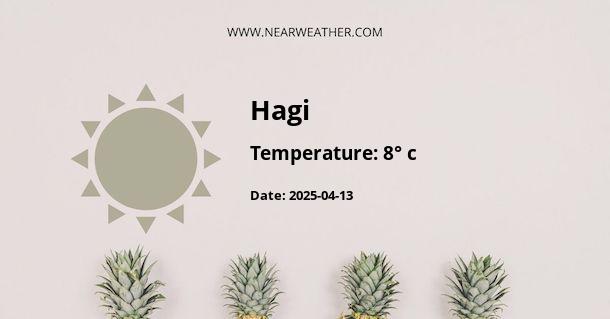Hagi, Japan: Climate and Weather Year Round
Hagi, located in the Yamaguchi Prefecture of Japan, is a beautiful city known for its rich history, stunning natural landscapes, and traditional architecture. When planning a trip to Hagi, it is essential to understand the climate and weather conditions throughout the year. This guide will provide you with detailed information about Hagi's climate, average temperatures, precipitation, and seasonal variations.
Climate Classification
Hagi experiences a humid subtropical climate, characterized by hot and humid summers and mild winters. The city is influenced by the warm Kuroshio Current and the Chugoku Mountains, which contribute to its unique weather patterns.
Temperature
The temperature in Hagi varies significantly throughout the year, with distinct seasonal changes. Let's explore the average temperatures for each season:
| Season | Average Temperature (°C) |
|---|---|
| Spring (March to May) | 10°C to 18°C |
| Summer (June to August) | 23°C to 31°C |
| Autumn (September to November) | 14°C to 22°C |
| Winter (December to February) | 3°C to 10°C |
As the table shows, summer in Hagi can get quite hot, with temperatures reaching up to 31°C. On the other hand, winter temperatures can drop to as low as 3°C. Spring and autumn offer milder temperatures, making them pleasant seasons to explore the city.
Precipitation
Hagi receives a moderate amount of rainfall throughout the year, with summer being the wettest season. Here are the average monthly precipitation levels in millimeters (mm):
| Month | Precipitation (mm) |
|---|---|
| January | 58 |
| February | 75 |
| March | 105 |
| April | 133 |
| May | 124 |
| June | 221 |
| July | 308 |
| August | 245 |
| September | 191 |
| October | 105 |
| November | 72 |
| December | 51 |
From the table, it is evident that June and July receive the highest amount of rainfall, making it the rainy season in Hagi. Autumn and winter months experience relatively lower precipitation levels.
Seasonal Variations
Hagi showcases unique beauty during each season, making it an ideal destination for year-round travel. Let's explore the seasonal variations and experiences:
- Spring: Spring in Hagi is breathtaking, with cherry blossoms painting the city in shades of pink. The Hagi Castle Ruins and the Shoin Shrine are particularly stunning during this season.
- Summer: Summers in Hagi can be hot and humid, but the city's proximity to the Sea of Japan provides a refreshing coastal breeze. Take a dip in the beautiful beaches such as Kasayama Beach and enjoy fireworks festivals.
- Autumn: Autumn brings vibrant colors to Hagi, with the foliage turning into shades of red, orange, and yellow. The Aiba Waterfall and Mount Shizuki offer picturesque hiking trails to witness the beauty of the changing leaves.
- Winter: Winter in Hagi is mild, with occasional snowfall adding a touch of magic to the city. Visit the famous Hagi Tenshukaku and Hagi Uragami Museum to learn about the city's history and enjoy traditional winter delicacies.
Conclusion
Hagi, Japan, experiences a humid subtropical climate with distinct seasonal variations. From the cherry blossoms of spring to the vibrant foliage of autumn, each season brings its own unique charm to the city. Whether you prefer warm summers or mild winters, Hagi offers something for everyone. Make sure to pack accordingly and plan your visit to experience the best of Hagi's climate and weather year-round.
A - Hagi's Latitude is 34.400002 & Longitude is 131.416672.
A - Weather in Hagi is 8° today.
A - Climate Conditions in Hagi shows light rain today.
A - Humidity in Hagi is 83% today.
A - Wind speed in Hagi is 29.92 km/h, flowing at 255° wind direction. today.
